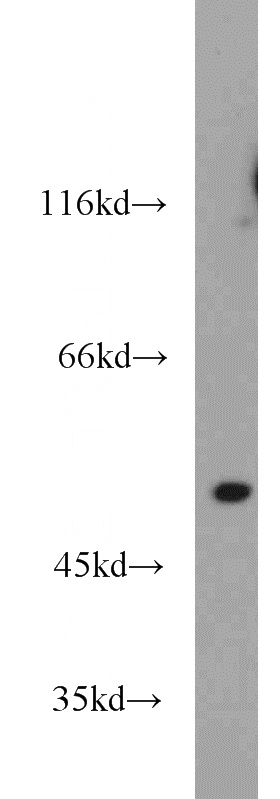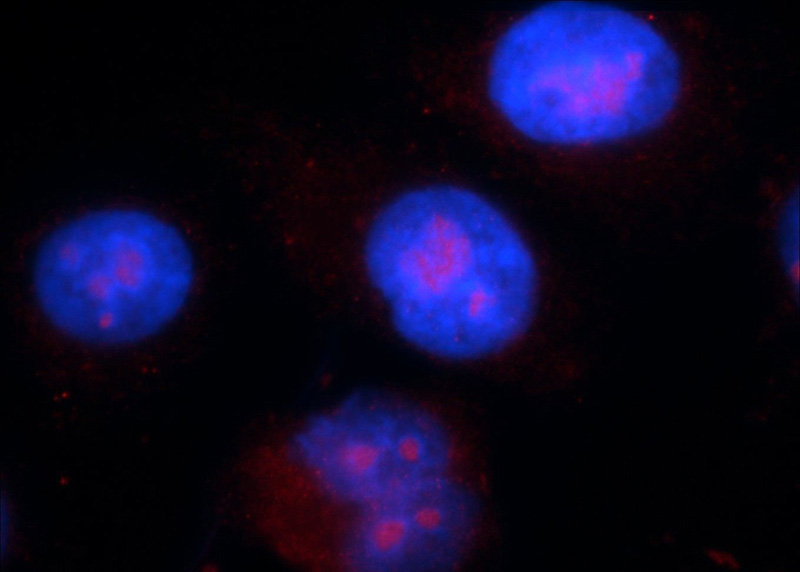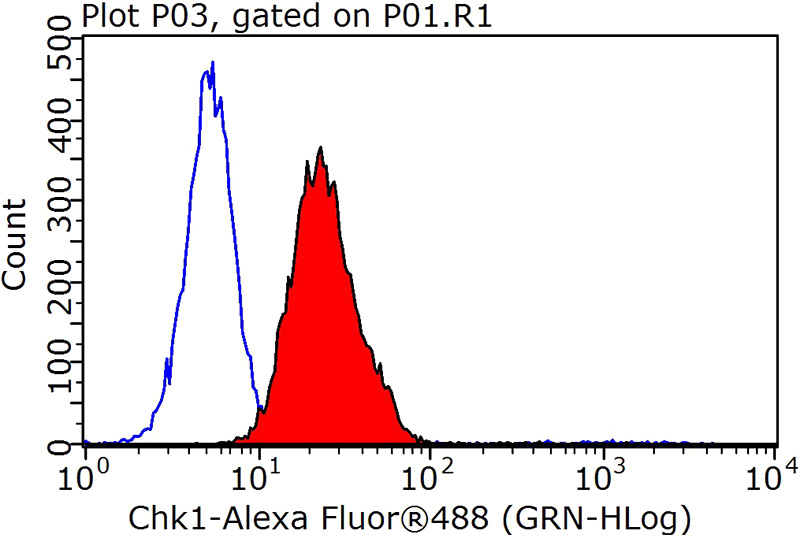-
Product Name
Chk1 antibody
- Documents
-
Description
Chk1 Rabbit Polyclonal antibody. Positive WB detected in mouse thymus tissue, HeLa cells, K-562 cells. Positive FC detected in HepG2 cells. Positive IF detected in HepG2 cells. Observed molecular weight by Western-blot: 50-55 kDa
-
Tested applications
ELISA, WB, IF, FC
-
Species reactivity
Human,Mouse,Rat; other species not tested.
-
Alternative names
CHEK1 antibody; Chk1 antibody
-
Isotype
Rabbit IgG
-
Preparation
This antibody was obtained by immunization of Chk1 recombinant protein (Accession Number: NM_001114122). Purification method: Antigen affinity purified.
-
Clonality
Polyclonal
-
Formulation
PBS with 0.1% sodium azide and 50% glycerol pH 7.3.
-
Storage instructions
Store at -20℃. DO NOT ALIQUOT
-
Applications
Recommended Dilution:
WB: 1:200-1:2000
IF: 1:10-1:100
-
Validations

mouse thymus tissue were subjected to SDS PAGE followed by western blot with Catalog No:109228(CHK1 antibody) at dilution of 1:1000

Immunofluorescent analysis of HepG2 cells using Catalog No:109228(CHK1 Antibody) at dilution of 1:25 and Rhodamine-Goat anti-Rabbit IgG

1X10^6 HepG2 cells were stained with 0.2ug CHK1 antibody (Catalog No:109228, red) and control antibody (blue). Fixed with 90% MeOH blocked with 3% BSA (30 min). Alexa Fluor 488-congugated AffiniPure Goat Anti-Rabbit IgG(H+L) with dilution 1:1000.
-
Background
In response to DNA damage, mammalian cells prevent cell cycle progression through the control of critical cell cycle regulators. CHK1 (synonym: CHEK1), a homolog of the Schizosaccharomyces pombe Chk1 protein kinase, is required for the DNA damage checkpoint. Human Chk1 protein is modified in response to DNA damage. In vitro Chk1 binds to and phosphorylate the dual-specificity protein phosphatases Cdc25A, Cdc25B, and Cdc25C, which control cell cycle transitions by dephosphorylating cyclin-dependent kinases. CHK1 can be autophosphorylated(PMID:22941630) and ubiquitinated(PMID:19276361). It has 3 isoforms produced by alternative splicing with the molecular weight of 54 kDa, 44 kDa and 50 kDa.
-
References
- Best A, James K, Dalgliesh C. Human Tra2 proteins jointly control a CHEK1 splicing switch among alternative and constitutive target exons. Nature communications. 5:4760. 2014.
- Pabla N, Bhatt K, Dong Z. Checkpoint kinase 1 (Chk1)-short is a splice variant and endogenous inhibitor of Chk1 that regulates cell cycle and DNA damage checkpoints. Proceedings of the National Academy of Sciences of the United States of America. 109(1):197-202. 2012.
- Song X, Li L, Shi Q. Polychlorinated Biphenyl Quinone Metabolite Promotes p53-Dependent DNA Damage Checkpoint Activation, S-Phase Cycle Arrest and Extrinsic Apoptosis in Human Liver Hepatocellular Carcinoma HepG2 Cells. Chemical research in toxicology. 28(11):2160-9. 2015.
- Qi W, Zhang W, Edwards H. Synergistic anti-leukemic interactions between panobinostat and MK-1775 in acute myeloid leukemia ex vivo. Cancer biology & therapy. 16(12):1784-93. 2015.
- Wang H, Dong D, Tang S, Chen X, Gao Q. PPE38 of Mycobacterium marinum triggers the cross-talk of multiple pathways involved in the host response, as revealed by subcellular quantitative proteomics. Journal of proteome research. 12(5):2055-66. 2013.
- Wu J, Chen W, Yin Y, Zheng Z, Zou G. Probing the cell death signaling pathway of HepG2 cell line induced by copper-1,10-phenanthroline complex. Biometals : an international journal on the role of metal ions in biology, biochemistry, and medicine. 27(3):445-58. 2014.
- Li X, Wang K, Ren Y. MAPK signaling mediates sinomenine hydrochloride-induced human breast cancer cell death via both reactive oxygen species-dependent and -independent pathways: an in vitro and in vivo study. Cell death & disease. 5:e1356. 2014.
Related Products / Services
Please note: All products are "FOR RESEARCH USE ONLY AND ARE NOT INTENDED FOR DIAGNOSTIC OR THERAPEUTIC USE"
